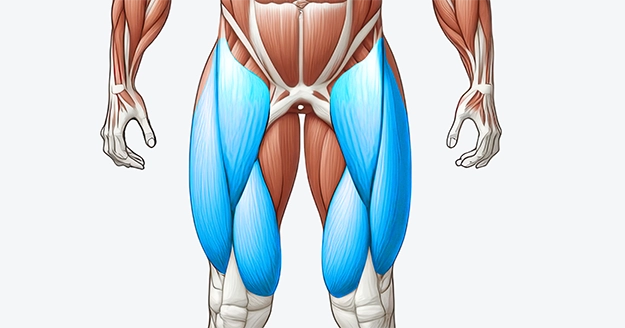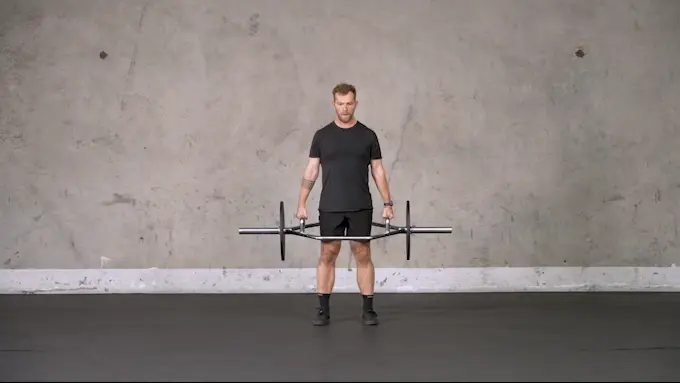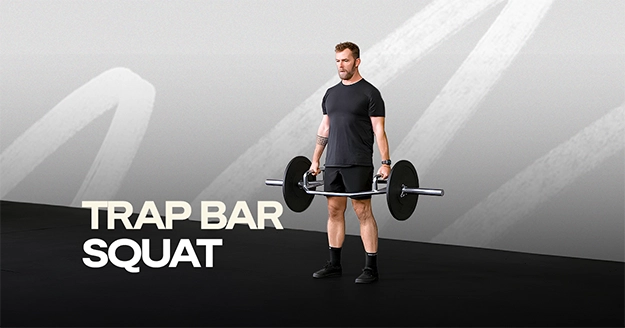Exercise Profile
Trap Bar Squat Overview
The Trap Bar Squat is a compound lower-body exercise that primarily targets the quads, glutes, and traps while engaging the core for stability. Using a trap bar provides balanced load distribution, which lessens stress on the lower back compared to traditional barbell squats.
For beginners, the trap squat bar is a great introduction to weighted squats, as the neutral grip and centered load make it easier to maintain proper form. Expert lifters can raise the weight or use techniques like paused or tempo squats to challenge their strength and stability further.
Various exercise regimens can use the trap bar squat to increase power, strengthen the lower body, or boost functional fitness in general. It’s an excellent choice for leg day or total-body workouts.

Trap Bar Squat Instructions
Step 1: Step into the middle of the trap bar and take a hip-width stance. Squat down and grab the middle of the low handles with straight arms. Your thighs should level with the floor, and your arms should align with your midfoot.
Step 2: Slightly tug on the bar to load and activate the working muscles. Retract your shoulder blades and extend your knees just enough to remove the bar’s slack. Then, brace your core.
Step 3: Extend your knees by pushing off the floor, keeping your hips low and your torso as upright as possible. Continue pushing until you reach full knee and hip extension, focusing more on driving the movement with your legs.
Step 4: Bend at the hips and knees until the weights touch the floor, then exhale.

Common Trap Bar Squat Variations
The squat with trap bar is a flexible exercise that can be customized to target specific muscle groups or help you rise to a new difficulty level. Here are some common variations to try during your next workout:
Trap Bar Squat Tips
- Throughout the exercise, keep your chest high and your back straight. This helps prevent injury and ensures that you’re engaging the right muscles.
- Experiment with your foot placement. A shoulder-width stance typically works best, but slight adjustments can help you find a comfortable and stable position.
- To maximize trap bar squat benefits, brace your core before descending. This stability is crucial for maintaining balance and protecting your lower back.
- Focus on a gradual, controlled lowering to increase muscle activation and minimize the chance of injury. Explode upward as you return to the starting position.
- Prepare your muscles and joints by warming up before your workout. Incorporate dynamic stretches and lighter movements to improve mobility and reduce the risk of injury.
Trap Bar Squat Common Mistakes
- Improper Back Position: Rounding or over-arching the back can lead to injury. When squatting, keep your back straight and tighten your core.
- Inadequate Depth: Not squatting low enough can limit muscle engagement and effectiveness. Squat to at least parallel, and ensure your knees stay aligned with your toes.
- Lifting with the Back: You are more likely to get hurt if you use your back to lift the weight instead of your legs. Focus on pressing through your heels and using your legs to push yourself upward.
Frequently Asked Questions
Is a trap bar effective for squats?
Yes, a trap bar is great for squats because it supports proper form and reduces strain on your back. Its balanced design allows for deeper squats and better engagement of the target muscles.
How much does a Trap bar weigh?
A standard trap bar typically weighs between 18 to 32kg, depending on the specific design and brand. Some specialty trap bars may weigh more or less, so checking the manufacturer’s specifications is a good practice.
How does the trap bar squat compare to the traditional squat?
The trap bar squat has a neutral grip and balanced weight, which helps you maintain good form and reduce the risk of injury.
Can you gain muscle using a trap bar?
Yes, you can build muscle with a trap bar, as it effectively targets the lower body and engages the core.
Is a trap bar safer than a barbell?
Yes, a trap bar is typically seen as safer than a barbell. Its design promotes better posture and alignment, reducing the risk of lower back strain and injuries during lifts.
Post your post-workout selfies in IG and tag @trainestapp, #trainest, or DM them to us to get a shoutout on Trainest Stories!


